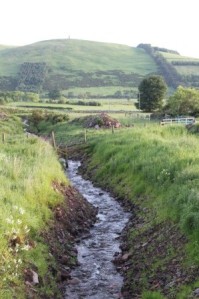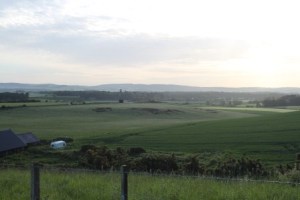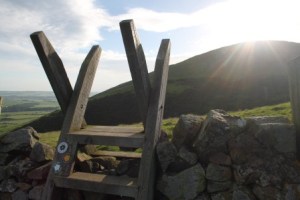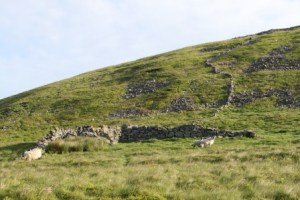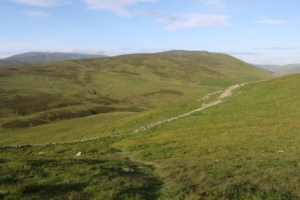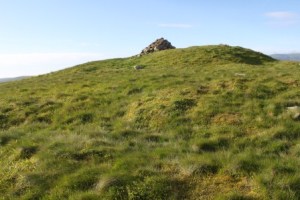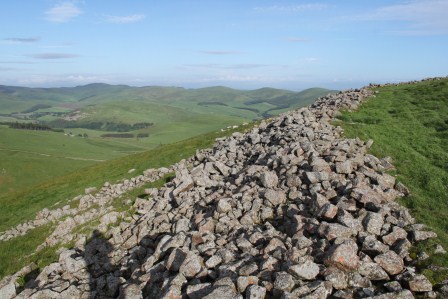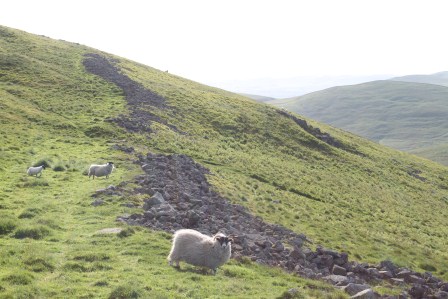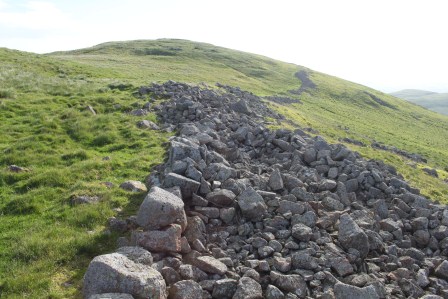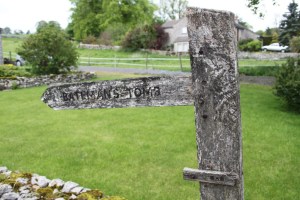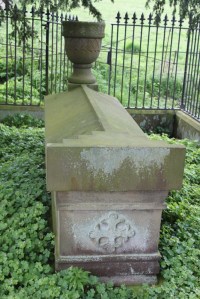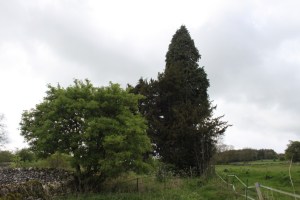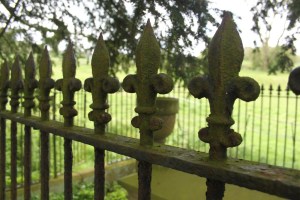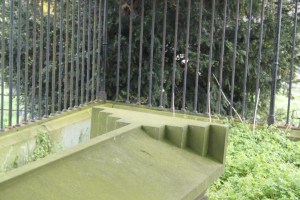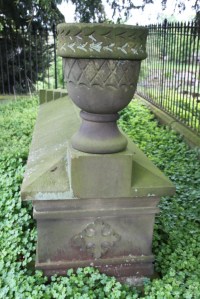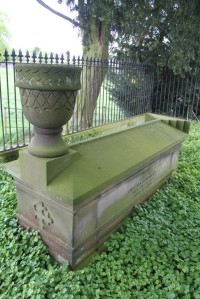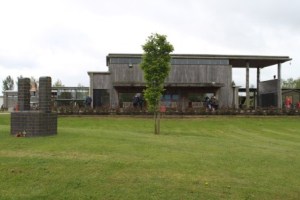
Millennium chapel and bell
Re-posted from Archaeodeath
In a previous blog post I discussed an article published online in January 2013 in the International Journal of Heritage Studies in which I explored the varied and complex ways in which ancient pasts – the British Prehistoric, Greco-Roman, Egyptian, Medieval – have been materialised in the many 21st-century memorials of the National Memorial Arboretum, Alrewas, Staffordshire.
Housing c. 300 memorial gardens and woods and many thousands of memorial plaques and trees, the NMA is the UK’s national focus of remembrance established around the Millennium. The centre-piece is the massive Armed Forces Memorial, bearing the names of every service man and woman killed on active service with British forces since 1945 and with new names inscribed upon its sad surfaces each year.
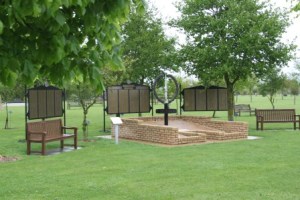
The Commandos Memorial – recently redesigned
My consideration of the NMA in this article was intended partly as a case study in the archaeology of contemporary conflict commemoration. Yet the NMA is more than a war memorial. Simultaneously my work was aimed to be a study of a unique cenotaphic (i.e. this is not a cemetery) memorial landscape for the UK with significance extending beyond conflict and the military.
I argue that the NMA is more than a collection of memorials to individual subjects. Conversely, the NMA is not really a fully and coherently designed landscape of mourning, nostaglia and future-orientated remembrance.
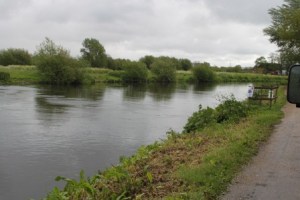
The river walk
The key point is that the NMA is an ever-changing memorial space as the trees and plants grow and mature, but also as the landscape acquires ever more memorials that progressively alter and adapt its form. Therefore rather than a ‘designed landscape’, it is instead better seen as a cumulative assemblage of commemorative projects that interact and intersect in pre-designed and ad hoc and unexpected fashions. It is a place for formal ceremony but also personal, family somatic mourning and commemoration through trees, plants, stones but also texts and other material cultures.
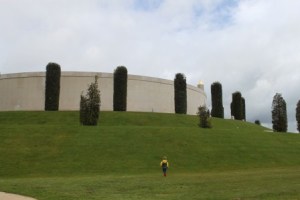
The Armed Forces Memorial, NMA
It is against this background that we can understand the uses of antiquity at the NMA; to create an aura of temporal transcendence and hence projection into the future, linked to the site’s key metaphor of the site of ‘growing remembrance’. A key example of the use of antiquity at the NMA include the Armed Forces Memorial that overtly draws on elements of British prehistory, Ancient Greece and Ancient Egypt in its design to create a temple to honour fallen heroes. Key to this use of antiquity is the fact that the Armed Forces Memorial is not finished – each year new names are added, with the capacity for it to continue to be filled with the names of Britain’s military dead for many decades to come.
The article has now been published in print and afforded a volume number as follows:
Williams, H. 2014. Antiquity at the National Memorial Arboretum, International Journal of Heritage Studies 20(4): 393-414.

On the land train
A Recent Visit
Coinciding with this publication, I recently revisited with my three-year old son. He was by far the youngest person there on a Sunday in May when the principal component of visitors were to attend a memorial service at the Fire Fighters memorial grove. I saw no other pre-school children visiting the site.
Because I was with a young boy, I engaged with the site differently than I did on previous trips and this was interesting in itself. I couldn’t systematically explore all the memorials as I would have liked, but had to adapt to my son’s interests and endurance. We also had to content with heavy showers and strong winds.
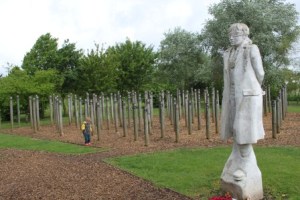
The Shot at Dawn memorial
The Land Train
On previous visits I walked around the NMA. At my son’s request, this time I went on the land-train. This proved to be a very slow tour of the principal memorials with audio-commentary and we got to avoid some of the showers.
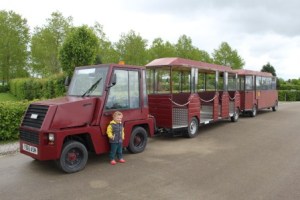
The land train
Still, my son was very frustrated by the slowness of the train, the wind and the rain. Meanwhile, I noticed a number of glaring mistakes in the intonation and the facts communicated in the audio-commentary. We gave up half-way around and went to see the Shot at Dawn memorial.
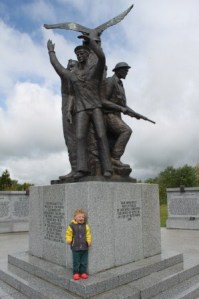
The Polish Armed Forces Memorial
Touring by Foot
We then went past many other memorials: Toby really liked the Polish Armed Forces memorial because of its fabulous eagle. We caught up with the land train passengers, almost beating them to the base of the Armed Forces Memorial and walked around, looking up at the many hundreds of names of those that ‘gave their lives’.
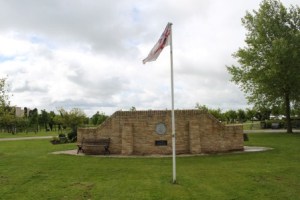
The rear-side of the SATF Memorial
The South Atlantic Taskforce Memorial
One of the key reasons for going back to the NMA was to look again at this memorial, opened to commemorate the 30th anniversary of the Falklands Conflict in 2012. given that I had presented a paper at the Bournemouth TAG conference in the session Archaeologies of Margaret Thatcher about the commemoration of the Falklands Conflict. Hence, I was very interested to look again at the Taskforce Memorial and its many dimensions, augmenting my existing photographic record and considering again, subsequent to my TAG presentation in December of last year, how the memorial operates in terms of its texts, materials and space.
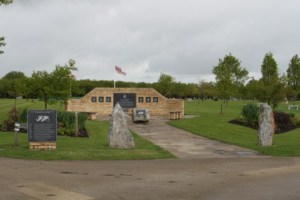
South Atlantic Taskforce Memorial – front.
The land-train commentary claims that it is a replica of the Port Stanley memorial, but of course, this is not fully correct, since the memorial is also reflective of the Blue Beach Military Cemetery at San Carlos Bay, East Falkland. One of the key dimensions of the memorial is its pivotal location in the NMA and its invocations of the South Atlantic in its form in replicating dimensions of multiple memorials in the Falklands and the selection of stones from the islands as well. The exchange between the Falklands and the NMA is two-way, because of course British servicemen were buried at the Blue Beech cemetery, but the memorials there were made of Cotswold stone, as is the NMA’s memorial.

My son standing with the names of those that gave their lives in the Falklands Conflict in 1982 inscribed upon the Armed Forces Memorial
Of course another dimension of the NMA is the networking of memorialisation between memorials. So one can visit the Falklands memorial but also up on the hill at the Armed Forces Memorial one can read the names of all those that died. This is another theme I discussed in my TAG paper: at the NMA the Falklands Conflict – those that served and those that died – is not commemorated in the South Atlantic Taskforce Memorial alone, but through a meshwork of locales including the Armed Forces Memorial itself.
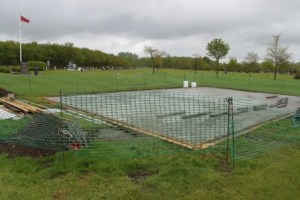
Building work without a plaque – unfolding commemoration
New Memorials
Another key reason to visit was to gain a sense of how the NMA is cumulative, as stated above.
On this visit, I noticed new plantings and arrangements applied to existing memorials. I saw that memorials I photographed only two years ago have been redesigned, such as the Commandos memorial.

View of the building work, I think preparing groundwork for the Camp Bastion memorial, repatriated from Afghanistan following the British withdrawal
Close by the Falklands memorial there were plaques denoting the location of future memorials yet to be designed, including the one pictured here which has no plaque denoting what it is. There was also evidence that the Camp Bastion memorial from Afghanistan is being installed near the Armed Forces Memorial following its ‘repatriation’.

The rear of the Battle of the River Plate memorial
The Battle of the River Plate
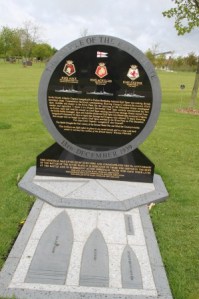
The front of the Battle of the River Plate memorial
Among the new memorials at the NMA is a new memorial that has been completed and dedicated is the Battle of the River Plate memorial. The NMA regard this as the 300th memorial to be dedicated at the gardens, remembering the 75th anniversary of the Battle of the River Plate.
The memorial consists of an above-ground two-sided memorial commemorating those on HMS Ajax, HMS Achilles and HMS Exeter who served and died in the battle and acheived victory against the German pocket battleship Graf Spee.
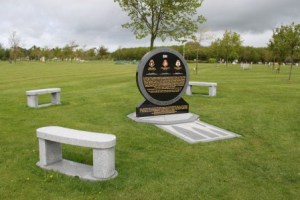
The Battle of the River Plate Memorial
The front side focuses on the British ships and their relative size to the Graf Spee, whilst on the rear-side is a map locating the conflict and an image of the German ship. Around the memorial are benches dedicated to the commanders of the British ships. Another fascinating element is that a small plaque states that beneath the monument are buried the names of all who died; an interesting piece of burial as a memorial act; the key to the memorial is here the mixture of texts seen and unseen.
It is no coincidence that this memorial has been placed adjacent to the South Atlantic Taskforce Memorial and shares with it dimensions and design elements, including maps of the South Atlantic. Therefore, with the addition of this new memorial, a new dimension to the interplay between memorial gardens has been created – a South Atlantic space interweaving a series of memorials to conflicts separated over time and space.



